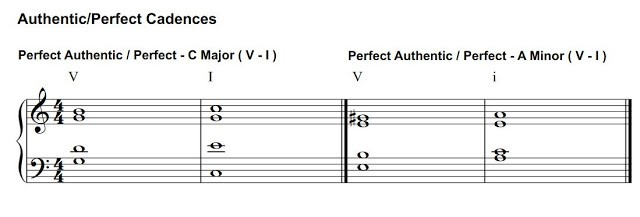4 Types Of Cadences In Music You Need To Know

Types of Cadences
There are four main types of cadences; which are Authentic Cadence, Half Cadence, Deceptive Cadence, and Plagal Cadence. These four (types of cadences) division are based on their harmonic progression.
Two of them sound finished, whilst the other 2 sound unfinished. Both of the finished types of cadences sound finished because they end on chord I. Unfinished types of cadences sound unfinished because they don’t end on chord I.
When you hear an unfinished cadence at the end of a phrase it sounds like the music should not stop there – it sounds like it should continue onto the next section.
4 Different Types Of Cadences
The four different types of cadences we have in Western harmonic music are listed below.
The four are the basic types of cadences we have in music theory to create a resting point in a musical composition.
The Authentic Cadence
This cadence is also called Final Cadence. It is a progression from dominant to tonic harmony. The chords of this cadence are generally in a root position. An authentic cadence is the most basic form of ”the end,” composed of two chords, the V and I.
An authentic cadence occurs whenever a phrase ends with V or vii° going to I (or i if minor). So an authentic cadence in C Major starts with a G chord and resolves with a C chord.
A seventh may be added above the root with a progression from the fifth to the first in major keys, or V to I in the minor keys. This cadence is simple, fulfilling, and aesthetically pleasing. This is one of the strongest cadence types that is available under common practice tonality.

The authentic cadence may be perfect or imperfect, (Some theorists call a half cadence an imperfect cadence.) perfect when the tonic chord is arranged with its root in both outer voices, and imperfect when the uppermost voice sounds factor 3 or 5 in the tonic chord.
The authentic cadence when preceded by subdominant harmony is called complete cadence. The effective use of the authentic cadence is at the end of a period.
ALSO READ : A Complete Guide To The Types Of Form In Music
There are two types of authentic cadences that are used in music:
1. Perfect authentic cadence (PAC)
2. Imperfect authentic cadence (IAC)
Perfect authentic cadence:
In a PAC, the two chords that make up the cadence are both in their root positions, meaning that the note on the bottom of the stack is the root, the note the chord is named after.
The very strongest PAC occurs when the second chord, the I/i chord, has the root of the chord on both the bottom and the top of the stack of notes; this makes for a very high-impact sort of end to a song.

The average G chord is made of G, B and D. If those notes appear in that order, G will be the lowest note. However, in a perfect authentic cadence, the note in the lowest position of the I chord is repeated in the highest position.
In our C Major composition, that last chord could look like this: CEGC. Altogether, our V-I would be GBD– CEGC. That’s a perfect authentic cadence. Beethoven’s “Ode to Joy” ends with just that type of cadence.
Imperfect authentic cadence:
Every other V–I chord progression is called an imperfect authentic cadence (IAC), and it’s basically anything that isn’t a perfect authentic cadence. A cadence ending in the V–I pattern but with different notes in the root of either chord and/or without the I chord capped by the tonic note (the note the key is named after), makes an imperfect authentic cadence.

For example, the V/v chord could be in some inversion. In the I/i chord shown below, or there’s a melody note moving between the chords. If we have V–I perfect authentic cadence is GBD– CEGC, an imperfect authentic cadence could be DGB– GCE.
Both of these have a G chord followed by a C chord, but the imperfect cadence messes with the expected composition of those chords. The difference between a PAC and an IAC is illustrated in diagram above.
More explanations on Authentic Cadence can be found on The Quick Guide To Authentic Cadence In Music.
The Plagal Cadence (Types Of Cadences)
This also called Church Cadence, Ecclesiastical Cadence, and Amen Cadence. This cadence is a progression of the subdominant chord to the tonic chord. This cadence is very common in hymnals, offered as the “Amen” portion of the ending in a song.
This also brings closure but does not have the finality of the leading note rising to the tonic. It is usually expressed as V-I-V, but it can also be expressed as I-IV-I. The progression is IV to I and often the melody stays on the tonic. It can be used as a major cadence, a minor cadence, or a combination of both.

This cadence is effective after the final cadence in ecclesiastical music. Endeavour to Read The Basic Guide To The Plagal Cadence In Music for more information about Plagal Cadence.
The Half Cadence (Another Types Of Cadences)
This cadence is a progression from tonic or subdominant harmony to dominant harmony. This cadence ends on the fifth and can be proceeded by any other chord. It can start on chord I, II or IV. This causes the musical composition to sound somewhat incomplete, which suspends the piece in the mind of the listener.
Variations of this cadence may raise the chord by a half-step, creation semi-tonal motion within the bass, or offer parallel fourths between the upper voices.

The music clearly sounds like it should continue. Its effective use is at the end of any phrase other than the last phrase of a period.
You can read A Complete Guide To Half Cadence for more about half cadence.
The Deceptive Cadence
This is also known as Interrupted Cadence, False Cadence and Avoided Cadence. It is a progression from dominant harmony to some chord other than I, usually VI and occasionally IV preferably in first inversion.
ALSO READ: Facts You Need To Know About Musical Notation
This cadence ends on an unexpected chord and the music literally does sound like it has been “interrupted”, creating an irregular resolution to the composition.
It offers a suspended feeling to the listener, often repeating chord progressions in such a way that a conclusion is expected, but never comes.
It could be said that a composer using this cadence will “sidestep” to a different key in order to bring the composition to a conclusion. The most common chord progression you will come across is from chord V to chord VI (V-VI).

The music sounds like it is unfinished; it sounds like it has just paused and should now continue onto a new section. Its effective use is at the end of a phrase other than the last phrase of a period.
It is effectively used also to extend the normal length of a period. Read The Quick Guide To Deceptive Cadence In Music for more explanation on Deceptive cadence
Final Thought
We have described the main four types of cadence we have above, though there are other cadence opportunities that can be used in music theory in addition to the four common types.
An inverted cadence will follow one of the four common types, but invert the last chord of the composition. An upper leading-tone cadence utilizes a trill throughout the key to place an emphasis on the whole tone to draw out an authentic cadence conclusion.
The first step in becoming comfortable with cadences is to start identifying them in music that is very familiar to you. Find the pauses and stops in the music.
Do a harmonic analysis of the last few chords before each stop, and identify what type of cadence it is. Then see if you can begin to recognize the type of cadence just by listening to the music.
At Phamox Music, we go all out for exactness and honesty. For this purpose, if by any means you found any possible glitch, be it factual, editorial or something that we need to update, kindly contact us.







